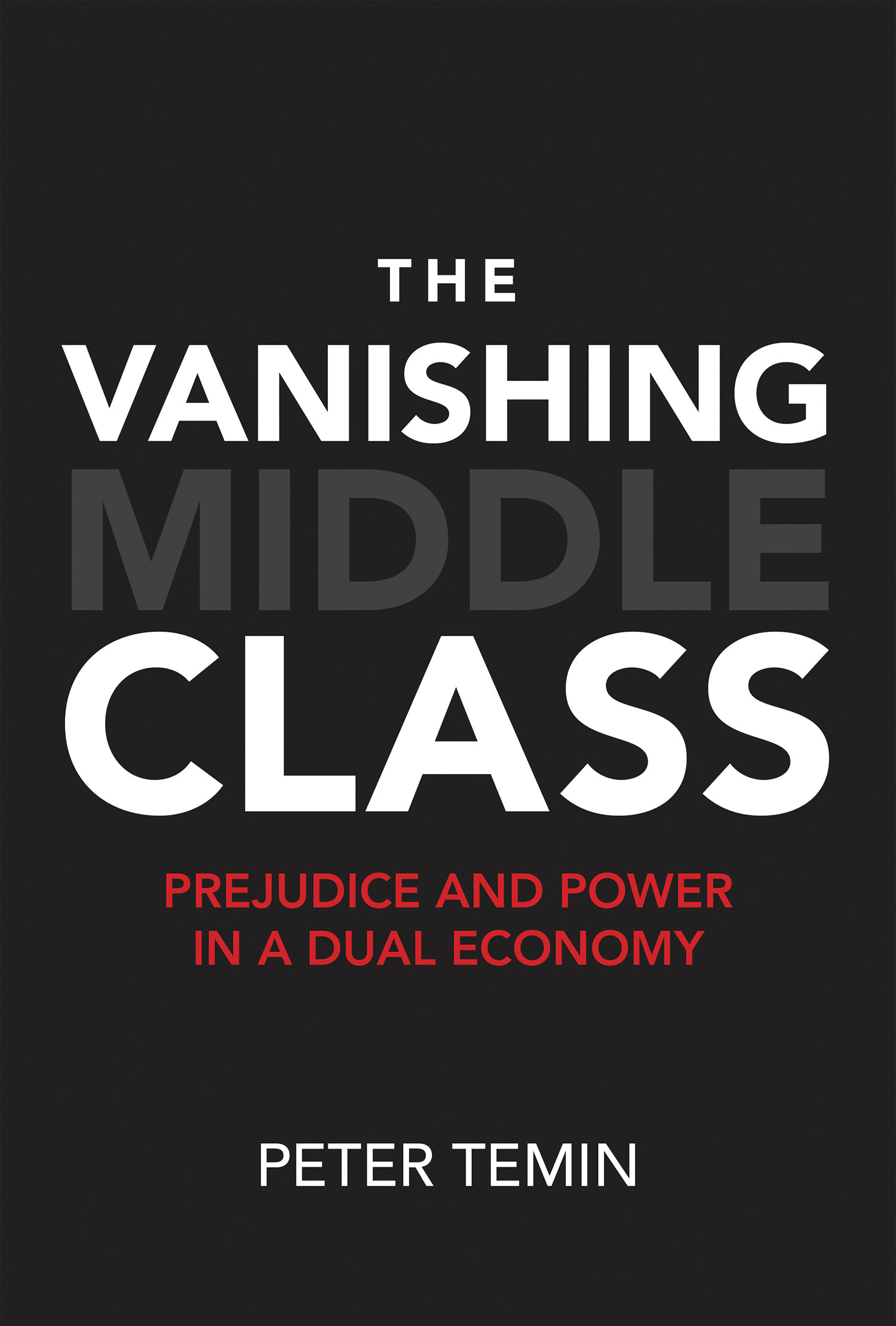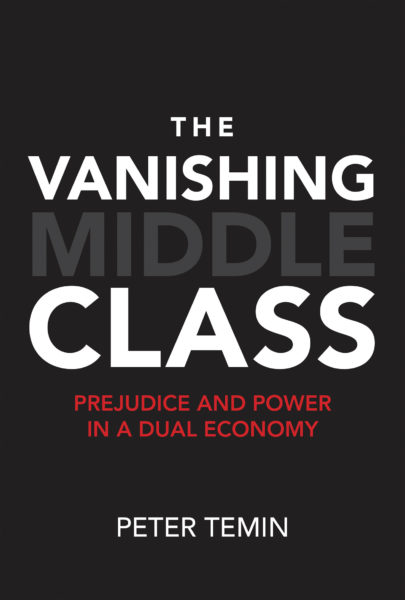In his new book The Vanishing Middle Class, MIT economist Peter Temin provides a short and accessible take on this country’s deeply unequal economy, which he argues now represents two different Americas. The first is comprised of the country’s elite workers: well-educated bankers, techies, and other highly skilled workers and managers, members of what he calls the “finance, technology, and electronics sector” (FTE)—the leading edges of the modern economy. A fifth of America’s population, these individuals command six-figure incomes and dominate the nation’s political system, and over the past half-century, they have taken a greater and greater share of the gains of economic growth. The other America, what he calls the “low-wage sector,” is the rest of the population—the dwindling ranks of clerks, assemblers, and other middle-income workers, and an expanding class of laborers, servers, and other lowly paid workers.
Drawing on the work of the Nobel Prize-winning economist W. Arthur Lewis, Temin describes this new reality as a “dual economy,” where the fortunes of the first America are all but disconnected from those of the second. Free trade and technological advances allow the FTE elites to make more money, pay lower prices, and enjoy an integrated global market’s many conveniences, even as those trends sweep aside many of the good jobs that the rest of America relies upon. Increasingly isolated, elites have little reason to care about less affluent communities, and much reason to want to reduce their taxes, so they tend to favor stripping away the safety net and pulling public funds from the schools the poor and middle class depend on. The American educational system, which used to be an engine of upward mobility that lifted many children of parents with few means into society’s upper echelons, has been split into two systems—separate and unequal.
Temin’s idea of a dual economy focuses our attention on how, if left unchecked, the workings of the market economy lead to disaster for those Americans stuck in the low-wage sector. FTE industries are booming, and capitalists seek to eke out even greater returns on their investments by lowering the cost of labor. In doing so, they have strong incentives to push down the wages and benefits of the bottom 80 percent of workers—importantly, even those who have nothing to do with their industries. The reason for this callousness toward the low-wage sector is pragmatic: a glut of underpaid or unemployed workers at the bottom makes their own workers so grateful to have decent jobs that they accept lower wages. In other words, what’s good for Silicon Valley and Wall Street is not good for ordinary Americans—and that’s a feature, not a bug, of the current system.
In his previous work with Frank Levy, Temin described how the Treaty of Detroit—a landmark contract reached in 1950 between General Motors and the United Auto Workers—epitomized a postwar economy of job security and high wages that raised the well-being of all workers, including those with little education (a central theme of my own book). In Temin’s new book, one of the most vivid illustrations of the changed reality that now faces America’s working class comes when he describes the situation of newspaper delivery workers:
Most of us do not think about how the paper gets to our door in the morning, but paper delivery has evolved into a grueling nocturnal marathon for low-income workers who work invisibly at the edge of the economy. Delivery drivers are classified as independent contractors rather than employees; they therefore do not get guaranteed health care or retirement savings. They work 365 days a year for pay that makes ordinary jobs look good, and they have to find a replacement if they need to take a day off. Many of them work at another job during the day to support their families. More and more working people are being forced into working conditions like these.
The day-to-day drudgery of today’s delivery driver is a symbol of the low-wage sector: work that children on bicycles used to do is now expected to support families, but with all the risk of success and failure piled on the workers themselves, who toil in the early morning hours, unseen by those they serve. And it is telling, too, that these conditions occur in an industry that is itself struggling to survive in the face of technological and economic changes.
Like Richard Reeves in his book Dream Hoarders, Temin doesn’t think we should only dwell on the top 1 percent of earners and their extraordinary ascent over the past few decades. As much as this group has made out like bandits in our unregulated Wild West economy, Temin’s focus on the FTE sector makes clear that a larger fortunate fifth of America has been benefitting immensely from the status quo, too. At the same time, a strength of Temin’s book is his in-depth discussion of how the top 1 percent has far outpaced the rest of the elite as well—largely due to their outsized political influence. He explains that a view of American democracy as an arena where the public clashes on important social issues, and the majority winner justly enacts policy, is simply naïve. In the real world of politics, people with money “invest” in politicians who then do their bidding—and the top 1 percent have more to invest than everyone else. In turn, racial prejudice (which he discusses at length, almost exclusively referring to bias against African Americans) weakens whatever public support exists for a stronger safety net for low-wage workers by casting the beneficiaries as undeserving outsiders.
By concisely and insightfully sketching out the contours of the modern economy, Temin’s book helps us to understand why workers in auto plants and office cubicles alike have fallen behind in recent decades. Their pursuit of the American Dream has been halted by stagnant wages and declining employment. Their working conditions have worsened thanks to the end of job security and management’s unchecked control in the workplace. The roots of their problems aren’t just economic, however, as his discussion of politics makes clear. Temin emphasizes how institutions like labor unions and government no longer push the economy toward a widely shared prosperity—as they did in mid-twentieth-century America, and as they still do in parts of Europe today. The implication is that, with the proper support, they can do it here again.
Recognizing that labor unions in America have been all but stamped out in many sectors, Temin seems to pin his hopes on government intervention on behalf of ordinary workers, particularly to promote high-quality, broadly available education and training. This hope, however, seems very much at odds with the gloomy picture of a corrupt and unresponsive political system he sketches out for much of the book. In other words, as compelling as his diagnosis of the problem is, he doesn’t say much about how to bring about the sort of democratic renaissance that could solve it.
But these are the big, unresolved question in our politics today. Can unions can be revived, and thus provide a countervailing force to restrain the excesses of corporations? To what extent can union power be replaced by the organizing of the so-called alt-labor movement—worker centers and nonprofit networks working outside the formal union-management negotiating process? And what role can social movements, knitted together through grassroots organizing, play in making sure the country’s political system starts responding again to the popular will?
We academics tend too often think in technocratic policy terms. We typically want to devise the innovative policies and then assume that a can opener of bold government action could open up the system to change. We find it hard to imagine concrete and practical strategies that activists could actually use (though sociology has been better than most disciplines in offering such advice, and nonacademic research groups are increasingly taking on this role). Intellectuals’ most important contributions to social change have been ideas, ways of looking at the world that inform and inspire action. But as I argue in Cut Loose, scholars should also consider the political and cultural context when we propose policies.
While Temin could do more of this, his book provides a useful framing of the problem for those who want to fix it—dusting off the “Two Americas” rhetoric of a past political moment and reworking it for an even more unequal age.
This piece originally appeared in the blog Working-Class Perspectives.
Victor Tan Chen Victor Tan Chen is In The Fray's editor in chief and the author of Cut Loose: Jobless and Hopeless in an Unfair Economy. Site: victortanchen.com | Facebook | Twitter: @victortanchen
- Follow us on Twitter: @inthefray
- Comment on stories or like us on Facebook
- Subscribe to our free email newsletter
- Send us your writing, photography, or artwork
- Republish our Creative Commons-licensed content


